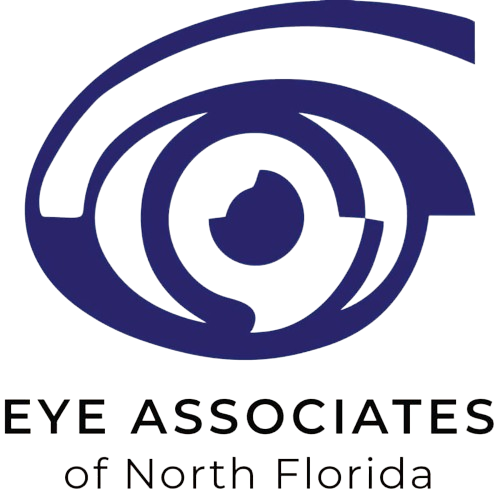Glaucoma Specialist In Tallahassee, FL
Glaucoma is an eye condition that can damage your vision, and in many cases, symptoms go unnoticed and undiagnosed. Without treatment, glaucoma can damage more and more fibers in the optic nerve and cause more damage and possibly permanent blindness. There are three major types of glaucoma. Open-angle and closed-angle (or acute) are the two most common types of glaucoma that affect millions of Americans each year. Fortunately, advances in laser technology have made it easier than ever to receive highly effective glaucoma treatment. A routine eye exam is highly recommended to ensure you are taking any necessary steps towards the care of your eyesight. Early detection and treatment by the doctors at Eye Associates of Tallahassee are the keys to preventing optic nerve damage and blindness from glaucoma.
Causes Of Glaucoma
The cause of glaucoma is unknown, but there are several risk factors that increase your risk of developing glaucoma. These include high eye pressure (called intraocular pressure, or IOP), older age, being African-American or Hispanic, and having a family history of glaucoma. Anyone with any of these risk factors should get regular eye examinations to look for glaucoma. Glaucoma damages vision by destroying the optic nerve, which connects your eye to your brain, and carries visual information to your brain for processing. When the optic nerve is damaged from glaucoma, you lose your vision. Your peripheral vision—or side vision—is lost first. If glaucoma remains untreated, vision loss creeps in toward the center, first causing tunnel vision, and then, eventually, blindness.
Low-Tension Glaucoma
Another form of the disease, poorly understood but not uncommon, is low-tension glaucoma. In this form, optic nerve damage occurs even though eye pressure stays within the normal range. Some experts believe that people with low-tension glaucoma may have an abnormally sensitive optic nerve or a reduced blood supply to the optic nerve caused by atherosclerosis — an accumulation of fatty deposits (plaques) in the arteries — or another condition limiting circulation. Under these circumstances, optic nerve damage can occur even with normal pressure.
Open-Angle Glaucoma
Open-Angle Glaucoma occurs when the drainage area (where your cornea and iris meet) stays open so fluid can drain, but tiny tubes on the trabecular meshwork do not work properly. Pressure then builds up when the fluid inside the eye is unable to drain. This type of glaucoma is usually painless and damages vision so gradually that you are not aware of trouble until the optic nerve is already injured.
Closed-Angle Glaucoma
Closed-Angle Glaucoma occurs when the drainage area of the eye suddenly becomes blocked. Unlike open-angle glaucoma, pressure often rises suddenly and damage happens quickly. When eye pressure builds up suddenly, an acute angle-closure glaucoma attack occurs. This type of glaucoma is less common than open-angle and may cause blindness if it is not treated right away.
Pigmentary Glaucoma
Pigmentary glaucoma, a type of glaucoma that develops more frequently in young to middle-aged men than in women. This is associated with a dispersion of pigment granules within the eye, which then appear to arise from the back of the iris. When the granules accumulate on and in the trabecular meshwork, they can interfere with the outflow of aqueous and cause a rise in pressure. Physical activities, such as jogging, sometimes stir up the pigment granules, depositing them on the trabecular meshwork and causing intermittent pressure elevations. This type of glaucoma can usually be easily diagnosed by your ophthalmologist
Pseudoexfoliative Glaucoma
This form of secondary open-angle glaucoma occurs when a flaky, dandruff-like material peels off the outer layer of the lens within the eye. The material collects in the angle between the cornea and iris and can clog the drainage system of the eye, causing eye pressure to rise. Pseudoexfoliative glaucoma is common in those of Scandinavian descent. Treatment usually includes medications or surgery.
Traumatic Glaucoma
Injury to the eye may cause secondary open-angle glaucoma. Traumatic glaucoma can occur immediately after the injury or years later. It can be caused by blunt injuries that bruise the eye (called blunt trauma) or by injuries that penetrate the eye. In addition, conditions such as severe nearsightedness, previous injury, infection, or prior surgery may make the eye more vulnerable to a serious eye injury. The abnormal formation of new blood vessels on the iris and over the eye’s drainage channels can cause a form of secondary open-angle glaucoma.
Neovascular Glaucoma
Neovascular glaucoma is always associated with other abnormalities, most often diabetes. It never occurs on its own. The new blood vessels block the eye’s fluid from exiting through the trabecular meshwork (the eye’s drainage canals), causing an increase in eye pressure. This type of glaucoma is very difficult to treat.
Symptoms of Glaucoma
Glaucoma results in slow progressive damage to the optic nerve, leading to a slow loss of vision. Peripheral or side vision is usually lost first, however, glaucoma can result in total vision loss if untreated.
Inside the eye, there is a constant production of fluid that normally flows out of the eye through a very small drain. This drain can become blocked for various reasons, resulting in an increase in intraocular pressure. The most common types of glaucoma — primary open-angle glaucoma and acute angle-closure glaucoma — have completely different symptoms.

Symptoms Of Primary Open-Angle Glaucoma
- A gradual loss of peripheral vision, usually in both eyes
- Tunnel vision in the advanced stages
Symptoms Of Acute Angle-Closure Glaucoma
- Severe eye pain
- Nausea and vomiting (accompanying the severe eye pain)
- Sudden onset of visual disturbance, often in low light
- Blurred vision
- Halos around lights
- Reddening of the eye
Both open-angle and angle-closure glaucoma can be primary or secondary conditions. They’re called primary when the cause is unknown and secondary when the condition can be traced to a known cause, such as eye injury, inflammation, tumor, advanced cataract or diabetes. In secondary glaucoma, the signs and symptoms can include those of the primary condition as well as typical glaucoma symptoms.
When should I see a doctor?
Don’t wait for noticeable eye problems. Primary open-angle glaucoma gives few warning signs or symptoms until permanent damage has already occurred. Regular eye exams are the key to detecting glaucoma early enough for successful preventive treatment.
The American Academy of Ophthalmology recommends a comprehensive eye exam for all adults starting at age 40, and every three to five years after that if you don’t have any glaucoma risk factors. After age 60, you should be screened every year. If you are African-American or have other risk factors for glaucoma, your doctor likely will recommend periodic eye exams starting between ages 20 and 39, and every one to two years after age 40.
In addition, be aware that a severe headache or pain in your eye or eyebrow, nausea, blurred vision, or rainbow halos around lights may be the symptoms of an acute angle-closure glaucoma attack. If you experience two or more of these symptoms together, seek immediate care at an emergency room or an eye doctor’s (ophthalmologist’s) office right away.
Treatment Options
iStent
iStent is the first micro-invasive glaucoma surgery device that improves your eye’s natural fluid outflow to safely lower eye pressure by creating a permanent opening in the trabecular meshwork. Eye Associates of Tallahassee is pleased to be among the first in our region to offer this advanced technology
Benefits of the iStent:
- Is safely implanted during cataract surgery
- Spares important eye tissue that is often damaged by traditional surgeries
- Does not limit treatment options that could help maintain your vision in the future
iStent is the smallest medical device ever approved by the FDA. It is placed in your eye during cataract surgery and is so small that you won’t be able to see or feel it after the procedure is over. iStent is designed to create a permanent opening in your trabecular meshwork and works continuously to improve the outflow of fluid from your eyes to help control eye pressure.
Prescription eye drops
In many cases, your eye doctor will begin treatment of glaucoma with medicated eye drops. There are different types of medically prescribed topicals that can help treat your eye disease. If your eye doctor prescribes more than 1 type of eye drop it is important to make sure that you follow all specific instructions for applying each type of drop. Your Tallahassee eye doctor will discuss with you the best way to apply the medication(s) as well as the guidelines to follow for timeframes between each application.
Argon Laser Trabeculoplasty (ALT)
ALT the most common laser surgery performed for open-angle glaucoma. The objective of the surgery is to help fluids drain out of the eye, reducing the intraocular pressure that can cause damage to the optic nerve and loss of vision.
Selective Laser Trabeculoplasty (SLT)
This is a relatively new laser treatment for open-angle glaucoma. The objective of the treatment is to help fluids drain out of the eye, reducing the intraocular pressure that can cause damage to the optic nerve and loss of vision. The selective technique is much less traumatic to the eye than ALT, which has been the standard laser procedure.
Tube Shunt Surgery
When the risk is high that other glaucoma treatment options will fail, an aqueous shunt surgery may be recommended. With this outpatient procedure, a flexible glaucoma drainage device is implanted in the eye to divert aqueous humor (the fluid inside the eye) from the inside of the eye to an external reservoir small tube or valve placed in the eye through a tiny incision. The tube shunt is made of silicone or polypropylene, a material that won’t break down in the body. The entire implant is covered with the eye’s own external covering.
Traditionally, tube shunts were used to control eye pressure in patients in whom other treatments had previously failed, or in patients who have had previous surgeries or trauma that caused scarring of the conjunctiva. Tube shunts have also been successful in controlling eye pressure in other types of glaucoma, such as glaucoma associated with uveitis or inflammation, neovascular glaucoma (associated with diabetes or other vascular eye diseases), pediatric glaucoma, traumatic glaucoma, and others.







